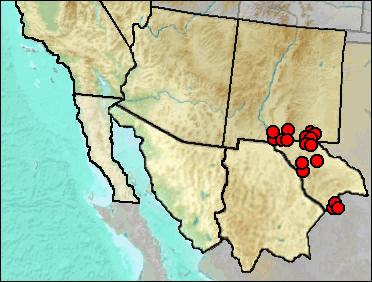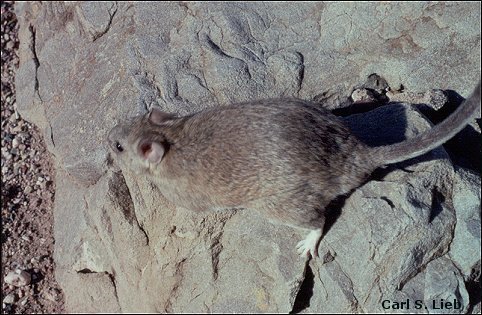Class Mammalia
Order Rodentia
Family Cricetidae
Subfamily Neotominae
Genus Neotoma

Synonyms. Neotoma albigula (part).
Originally described as a species in 1894, this taxon was later considered a synonym
of N. albigula. However, Planz et al. (1996) found that populations of N.
albigula east of the Rio Grande differed significantly in mitochondrial DNA from
populations west of the river. There was, however, representatives of both types in the
El Paso area. They noted that the Rio Grande has shifted between the two sides of the
Franklin Mountains during the Pleistocene and suggest this as a possible reason for the
sympatry. That is, when the river was east of the mountains, presumably the western
form inhabited them; when the river switched to west of the mountains, western forms
were suddenly on the eastern side, together with the eastern forms. Planz et al. stated
that the eastern form was a separate species, possibly referable to N. leucodon.
Edwards et al. (2001) performed a major study based on mitochondrial DNA and found much
the same pattern: White-throated Woodrats east of the Rio Grande and east and south of
the Rio Conchos in Mexico are a species separate from those west of the Rio Grande and
west and north of the Rio Conchos. They state unequivocally that those to the east
should be referred to as N. leucodon.
Fig. 1. Neotoma leucodon, University of Texas Indio Ranch Field Station, Hudspeth Co., TX. Photograph by Carl S. Lieb.
Edwards et al. (2001) also note that the genetic evidence indicates that the western species (N. albigula) appears most closely related to N. floridana, whereas the eastern species is most closely related to N. micropus. The mitochondrial DNA evidence also suggests that N. goldmani associates phylogenetically with the western species.
In the absence of clear morphological differences between N. albigula and N leucodon, fossils from east of the Rio Grande have been identified here as the latter species, but it should be noted that this is on geographic grounds only. Obviously those several sites in the vicinity of El Paso may be wrongly listed.
Sites.
Rancholabrean: Anthony Gap Cave (Harris 1984b).
Wisconsin: Big Manhole Cave (Harris 1993c).
Early/Early-Mid Wisconsin: Lost Valley (Harris 1984b); Rm Vanishing Floor (Harris 1984b); Sabertooth Camel Maze (Harris 1984b).
Mid Wisconsin: Navar Ranch (Van Devender et al. 1987: cf.); Pendejo Cave (Harris 2003); Tank Trap Wash (Van Devender et al. 1987); Tunnel View #6 (Van Devender and Bradley 1990: cf.); Tunnel View #8C (Van Devender and Bradley 1990: cf.).
Mid/Late Wisconsin: Animal Fair (Harris 1993c); Dark Canyon Cave (Tebedge 1988); Pit N&W Animal Fair (Harris 1993c: cf.).
Mid/Late Wisconsin/Holocene: Sierra Diablo Cave (UTEP).
Late Wisconsin: Animal Fair (Harris 1984b); Algerita Blossom Cave (Harris 1993c); Baby Vulture Den #5B(2) (Van Devender and Bradley 1990: cf.); Balcony Room (UTEP); Bennett Ranch #4 (Van Devender and Bradley 1990: cf.); Dust Cave (Harris and Hearst 2012); Ernst Tinaja #2B(2) (Van Devender and Bradley 1990: cf.); Harris' Pocket (Harris 1984b); Lower Sloth Cave (Logan 1983); Muskox Cave (Logan 1981); Navar Ranch (Van Devender et al. 1987: cf.); Pendejo Cave (Harris 2003); Tunnel View #3A (Van Devender and Bradley 1990: cf.); Tunnel View #17 (Van Devender and Bradley 1990: cf.); Upper Sloth Cave (Logan and Black 1979).
Late Wisconsin/Holocene: Beyond Bison Chamber (Harris 1993c); Conkling Cavern (Harris 1984b); Fowlkes Cave (Dalquest and Stangl 1984b); Pendejo Cave (Harris 2003); Tunnel View #12 (Van Devender and Bradley 1990: cf.); Williams Cave (Ayer 1936).
Literature. Ayer 1936; Dalquest and Stangl 1984b; Edwards et al. 2001; Harris 1984b, 1993c, 2003; Harris and Hearst 2012; Logan 1981, 1983; Logan and Black 1979; Planz et al. 1996; Tebedge 1988; Van Devender and Bradley 1990; Van Devender et al. 1987.
Last Update: 25 Jan 2013